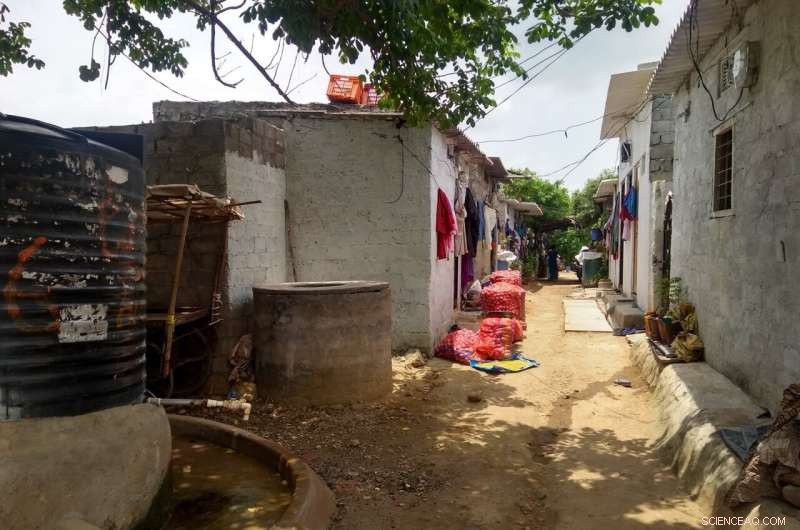
Questa foto è stata scattata in un'area periurbana vicino a Hyderabad, in India. In primo piano si possono vedere le infrastrutture disponibili per l'approvvigionamento idrico. L'area non è ancora stata collegata alla rete idrica convogliata, ma questi grandi serbatoi d'acqua possono essere riempiti tramite acqua piovana o con acqua consegnata nell'area da camion. Nella terra di mezzo si possono vedere grandi sacchi di cibo, che possono essere trasportati nella zona con automezzi, bestiame e a mano. Sullo sfondo è presente lo spazio verde rimanente, in netto contrasto con le abitazioni relativamente dense nella terra di mezzo. Credito:Professor Simon Willcock
Il mondo in cui viviamo è spesso diviso utilizzando una distinzione binaria urbano-rurale, nonostante un'enorme pendenza dei modelli insediativi all'interno e intorno alle città, che vanno dalle aree urbane alle zone rurali più remote. Nuova ricerca condotta attraverso un progetto di ricerca congiunto Regno Unito-India e pubblicata su Nature Sustainability , considera l'urbanizzazione osservando i cambiamenti nelle infrastrutture naturali, ingegnerizzate e istituzionali. Lo studio, incentrato sul Sud del mondo, suggerisce che il rapido cambiamento nelle aree suburbane (denominate "periurbane") fa sì che le persone che vivono in quelle aree abbiano una qualità della vita peggiore rispetto alle persone che vivono nelle aree urbane e rurali.
"La popolazione urbana mondiale continuerà a crescere portando a un pianeta sempre più urbanizzato, che spesso si traduce in un'espansione urbana, poiché le città si estendono verso l'esterno incorporando la terra circostante. Questa espansione delle città è particolarmente rapida nei paesi in via di sviluppo in Asia e Africa", afferma il professor Kenneth Lynch (Università del Gloucestershire).
Il professor Simon Willcock della Bangor University e Rothamsted Research afferma:"Man mano che le aree urbane si espandono, le caratteristiche e i servizi disponibili all'interno delle aree cambiano. Ad esempio, la natura e i prodotti naturali sono spesso più immediatamente disponibili nelle aree rurali, con livelli più bassi nelle aree urbane, mentre le infrastrutture costruite mostrano lo schema opposto, a volte anche accompagnato da un passaggio dalla leadership locale tradizionale nelle zone rurali a una governance più centrale nelle città."
La ricerca presenta una nuova teoria della turbolenza periurbana, come spiega il dott. Paul Hutchings dell'Università di Leeds:"Il tasso di danneggiamento della natura e il costo della costruzione di nuove infrastrutture sono fattori importanti nel determinare la qualità della vita delle persone che vivono in peri -aree urbane. Ad esempio, quando l'estrazione di prodotti dalla natura ha un costo ambientale elevato, la natura può sostenere solo un numero limitato di persone. Allo stesso modo, quando anche il costo della costruzione di infrastrutture è elevato, è economicamente sostenibile sostenere comunità. In una situazione come questa, è probabile che le risorse provenienti dal mondo naturale scompaiano prima di poter essere sostituite da infrastrutture costruite."
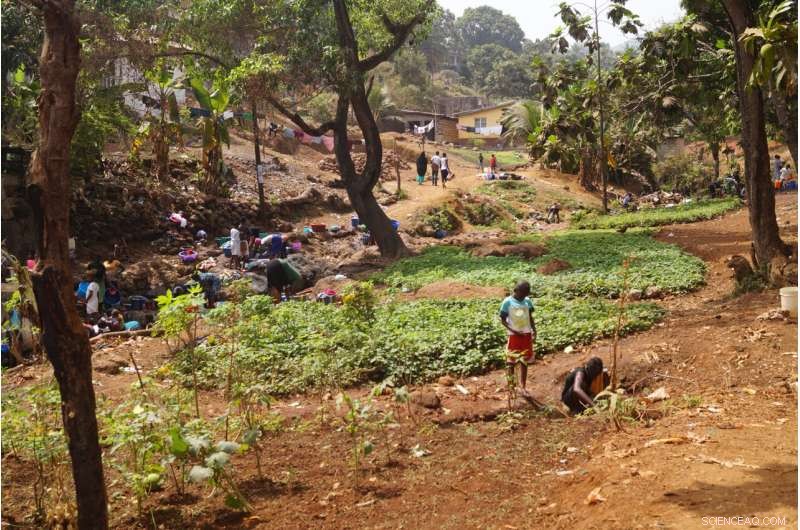
Questa foto è stata scattata tra due quartieri che guardano un ruscello vicino a Freetown, in Sierra Leone. In primo piano si vedono due bambini che estraggono acqua da un pozzo per innaffiare piccoli orti dietro di loro. In the middle ground, a group of women and children are washing clothes and themselves in the stream and up the slope and behind the banana trees, the residential dwellings, some of which are in construction. You can also observe, rubbish littering the catchment, building materials in the form of boulders, some of which have been arranged to reduce erosion and landslip and dotted about some mature trees, some of which show evidence of having branches removed for fuelwood. Credit:Professor Kenneth Lynch
"Previous evidence supports this. For example, child health in East Africa is lowest in those communities living between the city and countryside, whilst a study in South Africa found that around two thirds of urban and rural citizens report that their quality of life had improved over the last five years, but only half of respondents reported such improvement in peri-urban zones," says Professor Kenneth Lynch.
Professor Simon Willcock explains the limitations of the theory:"This type of negative experience in peri-urban areas is greater for some services than others, and varies across geographic areas. For example, most food is grown in rural areas, but this can also be done within cities. Food can also be transported by road within cities with relative ease. However, there are likely to be big differences between groups living in each context. For example, higher income households and communities living in peri-urban areas have better access to the scarce resources. They can buy-in their own water, electricity, sanitation and so forth."
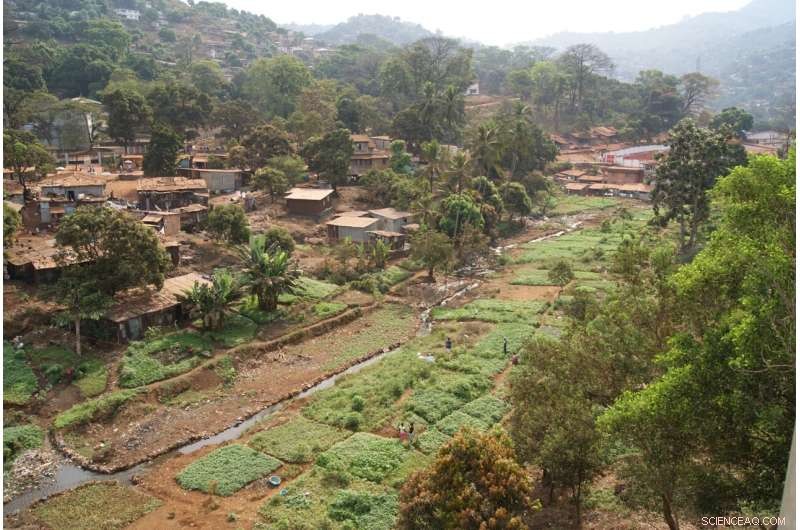
A site that floods during the rainy season that has thus far prevented development, allowing local people to use it for small-scale vegetable gardens near Freetown, Sierra Leone. Since this photo was taken two large developments have encroached on this site displacing the cultivators reducing the cultivated land cover and restricting the drainage channel, exacerbating flood water during the rainy season. Non-biodegradable waste (such as plastic bags and bottles) is used by cultivators to form drainage channels and protect plots from erosion. Credit:Professor Kenneth Lynch
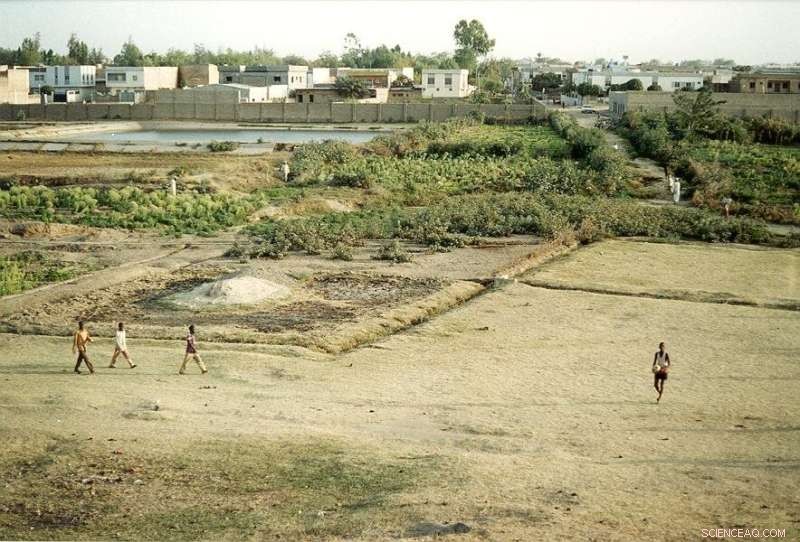
A seasonally flooded site within the old walls of the city of Kano, Northern Nigeria. You can see sites in the foreground are being used for small scale agriculture, but also plots have been marked out for construction and some sand and cement has been deposited ready for the installation of boundary markers. In the background you can see the high value residential areas that have a wall separating their neighborhood from the agricultural site. Many of the cultivators grow rice in the rainy seasons indicating this is for household consumption. During the dry season the cultivable land reduces to very close to the stream which is heavily polluted by nearby clothes dying works and the residential area. Encroachment on this site for residential development will exacerbate flooding further down the watershed. Credit:Professor Kenneth Lynch
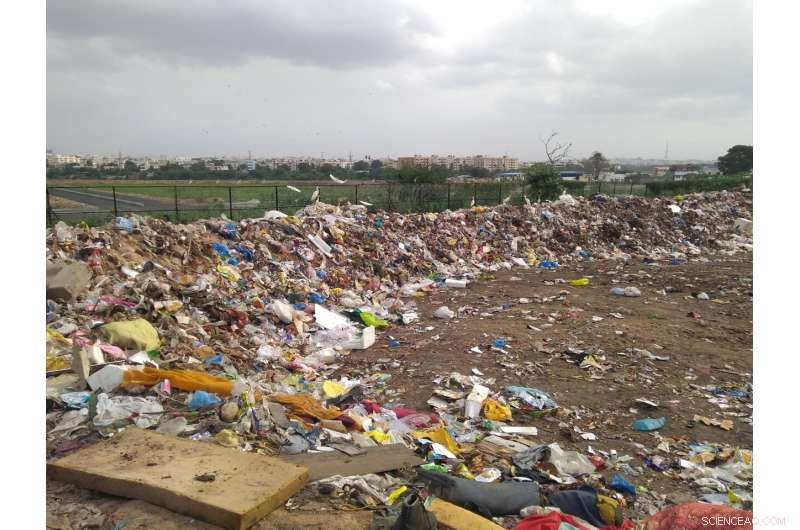
This photo is taken in a peri-urban area near Hyderabad, India. In the foreground, you can see a waste disposal area, receiving waste from the surrounding peri-urban areas, but also from the main city (shown in the background). This waste may present a hazard to the health of those living nearby, and risks polluting the nearby natural areas (shown in the middle ground). Credit:Professor Simon Willcock
Dr. Paul Hutchings concludes, "The bumpy road between natural and built infrastructure can be avoided. Some natural infrastructure can be conserved throughout urbanization through good city planning enforcing protection of green space. As well as this, services, such as municipal water utilities, can be subsidized so that they can be provided to people in peri-urban areas. Urban and rural planners, designers and architects should be working together to pre-empt the needs within newly expanded areas, and act quickly to prevent lower quality of life of the people living there." + Esplora ulteriormente